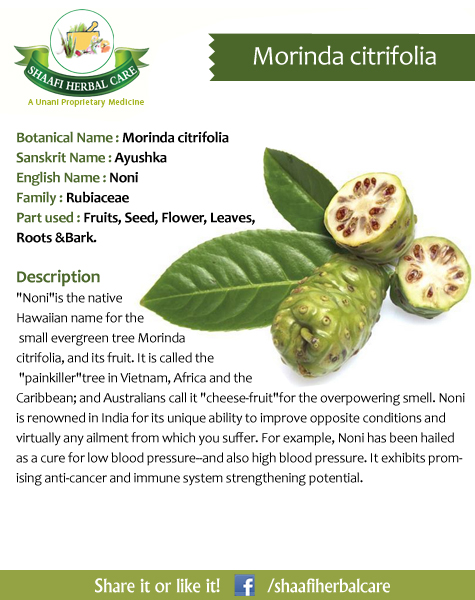
What is Noni?
The noni plant, native to Asia, Australia, and the islands of Polynesia, is a small, shrubby tree. The plant’s white flowers are tubular. The fruit is yellow-greenish-white in color and large, with a pebbled surface. The ripe fruit has a characteristic cheese-like, bad odor.
What is it used for?
Traditional/Ethnobotanical uses
Polynesian healers have used noni fruits for thousands of years to help treat a variety of health problems such as diabetes, high blood pressure, aches, pains, burns, arthritis, inflammation, tumors, the effects of aging, and parasitic, viral, and bacterial infections. Ancient healing manuscripts cite the fruit as a primary ingredient in natural healing formulations. Today, fruit preparations are sold as juice, in dried “fruit-leather” form, and as a dry extract in capsules.
General uses
Noni has traditionally been used for colds, flu, diabetes, anxiety, and high blood pressure, as well as for depression and anxiety. All plant parts are used for a variety of illnesses in Samoan culture, and noni is one of the most frequently used Hawaiian plant medicines. Claims that have not been proven in clinical trials include: the use of bark for the treatment of bacterial infections, cough, diarrhea in infants, and stomach ailments; the flowers for sore or irritated eyes, styes, conjunctivitis, ocular inflammation, and coughs; the fruit for asthma, wounds, broken bones, mouth and throat infections, tuberculosis, worms, diarrhea, fever, vomiting, eye ailments, arthritis, depression, seizures, bacterial and fungal infections, viruses, and as a tonic; the fresh fruit juice for cancer; the dried leaves used externally for infections, burns, children’s chest colds, and inflammation, and internally for boils, pleurisy, inflamed gums, and arthritic pain; the fresh leaves used externally for burns and internally for fevers, hemorrhage, bacterial infections, and inflammation; and the roots for oral ulcerations, fevers, and cancerous swellings.


